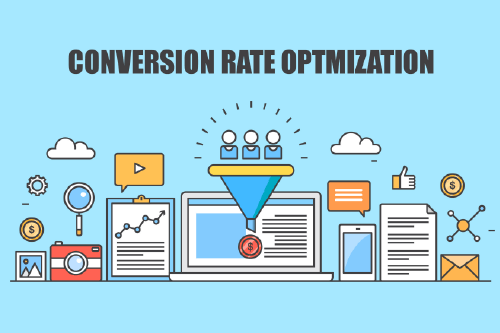Beginner’s Guide to Conversion Rate Optimization (CRO) for SEO
In today’s digital age, having a website is essential for any business that wants to reach potential customers. However, having a website alone is not enough. You need to optimize your website design and digital marketing strategy to drive website traffic and convert those visitors into paying customers.
This is where conversion rate optimization (CRO) comes into play. CRO is the process of optimizing your website to increase the percentage of users who take desired actions, such as making a purchase, filling out a form, or adding to their cart. With CRO, you can analyze user behavior, identify areas of improvement, and make changes to your website design and content to improve your website conversion rates.

Understanding Conversion Rate Optimization
You’ll need to understand the conversion funnel to get started with CRO. This is the path that potential customers take on your website, from the initial visit to completing a desired action. The conversion funnel typically includes landing, product, and shopping cart pages. By analyzing each step of the funnel, you can identify areas where users may be dropping off and make changes to increase the percentage of users who complete the desired action.
There are several CRO tools and analytics tools that you can use to optimize your website. Google Analytics is a powerful tool that can help you track website traffic and user behavior. Heat map tools can help you see how users interact with your website, while live chat can improve the user experience and increase conversion rates.
Conversion Rate: A/B Testing
Multivariate and split testing are popular CRO strategies that help you identify the most effective design and content changes. For example, you can determine which changes result in the highest conversion rates by testing different variations of CTA buttons, landing pages, and other elements.
When calculating conversion rates, it’s essential to consider the statistical significance. This ensures that the changes you make to your website result in higher conversion rates and not just due to chance.
Benefits of CRO
In addition to optimizing your website for higher conversion rates, CRO can also lead to other benefits, such as increasing revenue, reducing shopping cart abandonment, and improving the user experience. By identifying areas of improvement and making changes to your website design and content, you can increase the total number of conversions and the percentage of users who buy your products and services.
Case studies have shown that successful CRO can significantly increase conversion rates and revenue. By developing a CRO strategy and implementing the right tools and techniques, you can optimize your website for higher conversion rates and turn more site visitors into paying customers.
Conducting a Conversion Rate Optimization Audit
Before optimizing your website, you must identify where and why your visitors drop off. To do so, you can conduct a CRO audit to find and fix conversion bottlenecks. This includes identifying conversion bottlenecks, understanding user behavior, analyzing user data to identify areas of improvement, and using analytics tools and heat map tools to conduct a thorough audit.
- Identifying conversion bottlenecks on a website: Find out how to diagnose and fix issues preventing visitors from converting. This section will provide tips on how to identify conversion bottlenecks.
- Understanding user behavior on a website: Understanding user behavior is crucial for CRO. This section will explain how to track user behavior and analyze user data to identify areas for improvement.
- Analyzing user data to identify areas of improvement: This section will provide information on how to gather and analyze user data to identify areas for improvement.
- Tools and resources for conducting a CRO audit: This section will list the best tools and resources available to help you conduct a thorough audit.
How to Run CRO Audits
Following these steps, you can thoroughly audit a website and identify any issues affecting its performance, usability, and security.
- Analyze website performance: Use tools like Google PageSpeed Insights or GTmetrix to evaluate the website’s speed and performance. Look for issues affecting load times, such as large images or excessive code.
- Check website usability: Use tools like UserTesting or Hotjar to evaluate the website’s usability. Look for any issues preventing users from quickly navigating the site or finding the necessary information.
- Evaluate website content: Evaluate its content to ensure that it is accurate, up-to-date, and relevant. Check for any broken links, missing pages, or outdated information.
- Review website design: Evaluate its design to ensure it is visually appealing, readable, and consistent. Check for any design inconsistencies, such as mismatched fonts or colors.
- Check website security: Use tools like Qualys SSL Labs or Sucuri to evaluate the website’s security. Look for any vulnerabilities that may put users’ personal information at risk.
- Evaluate website accessibility: Use tools like WAVE or AChecker to evaluate the website’s accessibility for users with disabilities. Look for any issues that may prevent users with disabilities from fully accessing the site.
- Analyze website traffic: Use tools like Google Analytics or SimilarWeb to evaluate the website’s traffic and user behavior. Look for patterns or trends that may provide insights into how users interact with the site.
Best Tools for CRO
In addition to the best practices listed above, several tools can help you implement CRO on your website. Here are some of the best tools available:
1. Google Optimize
Google Optimize is a free tool that allows you to test different variations of a webpage to see which performs best. With Google Optimize, you can create and run A/B, multivariate, and redirect tests. The tool also integrates with Google Analytics, allowing you to track and analyze your test results effortlessly.
2. Crazy Egg
Crazy Egg is a heatmap tool that allows you to see how visitors interact with your website. The tool visually represents your website, showing which elements get the most clicks and which are ignored. This can help you identify which website elements must be optimized to improve your conversion rate.
3. Hotjar
Hotjar is a user behavior tool that lets you see how visitors interact with your website. The tool tracks visitor behavior, including clicks, scrolling, and mouse movements. This can help you identify areas of your website that may be causing confusion or frustration for visitors.
4. Optimizely
Optimizely is a popular A/B testing tool that allows you to create and run tests on your website. The tool also includes features for personalization, allowing you to show different versions of your website to different audiences based on their behavior and interests.
5. Unbounce
Unbounce is a landing page builder that allows you to create and test landing pages quickly and easily. The tool includes features for A/B testing, lead generation, and integrations with popular marketing tools.
More Tools
- Google Analytics (and GA 360)
- Adobe Analytics
- Heap
- FullStory
- Google Optimize
- Instapage
- HubSpot
- HelloBar
- OptinMonster
Best Practices for Conversion Rate Optimization
Once you’ve identified the conversion bottlenecks, it’s time to optimize your website to improve conversion rates. This section covers best practices for optimizing your website for higher conversion rates.
- Creating clear and concise calls-to-action (CTAs): CTAs are crucial for guiding website visitors towards the desired action. The CTA should be clear, visible, and aligned with the website’s objectives.
- Improving website loading speed: Website speed is a vital factor in the success of a website. The website should load quickly to keep the visitors engaged.
- Streamlining website navigation: Navigation is an essential factor determining the user experience. The navigation should be easy to use, and the user should be able to find what they are looking for without any hassle.
- Optimizing landing pages: A landing page is a visitor’s first impression of a website. It should be relevant, focused, and persuasive to capture visitors’ attention and direct them toward the desired action.
- Building trust with website visitors: Visitors are more likely to convert if they feel the website is trustworthy. Social proof, security, and credibility are factors that help to establish trust with website visitors.
- Testing and experimenting with website changes: Testing and experimentation are essential components of CRO. A/B and multivariate testing can help identify what works best for a website. Experimentation with different layouts, designs, and CTAs can help to improve the website’s conversion rates.
Measuring and Analyzing Conversion Rates
- Setting up conversion tracking: Conversion tracking tracks website visitors’ behavior and actions to determine how successful a website is at converting visitors. Google Analytics and other tools provide a range of features that can help to set up conversion tracking.
- Interpreting conversion rate data: The conversion rates metrics such as bounce rate, exit rate, and conversion rate can help to interpret how successful the website is in converting visitors. The data can be used to identify the areas that need improvement.
- Identifying areas for improvement through data analysis: Data analysis can help identify the website’s areas that need improvement. In addition, the analysis can help identify the factors hindering conversion rates and provide insights into how to improve them.
Advanced Techniques for CRO
You can use several advanced techniques and trends to take your conversion rate optimization (CRO) efforts to the next level. Here are a few:
- Personalization: Personalizing the user experience can increase conversion rates. You can use data like location, behavior, and demographics to personalize the website experience for each visitor.
- Machine learning: Machine learning can help you analyze large amounts of user data to identify patterns and predict user behavior. This can help you optimize your website for higher conversion rates.
- Chatbots: Chatbots can improve the user experience by providing quick and personalized responses to users’ questions and concerns. This can increase engagement and ultimately lead to higher conversion rates.
- Video marketing: Video marketing can be a powerful tool for increasing engagement and conversion rates. You can use videos to showcase products, provide tutorials, or tell your brand’s story.
- Voice search optimization: As more people use voice assistants like Siri and Alexa, optimizing your website for voice search can become increasingly important. Voice search optimization involves creating content that is optimized for natural language queries.
- Progressive web apps (PWAs): PWAs combine the features of a website and a native app to provide a seamless user experience. They can improve engagement and conversion rates by providing fast loading times and offline functionality.
Conclusion
In conclusion, CRO is essential for SEO as it helps to convert website visitors into leads, customers, or subscribers. By conducting a CRO audit, implementing best practices, and measuring conversion rates, website owners can optimize their websites for higher conversion rates and ultimately grow their business. CRO is an ongoing process, and website owners should continue experimenting and testing different strategies to identify what works best for their website.


